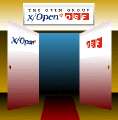Inside The Open Group
A Report on Emerging Technology and Standards

The Open Group Customer Council Takes Form
Combining the user groups of OSF and X/Open should give more power to
the customer's voice.
By Amy Auman
The world of open systems has always been highly political. This is
a common situation when people are trying to agree on something, which in
this case is specifications for technical solutions to certain information
technology problems. The open systems world is made even more political
by the number of companies and organizations competing to put forward their
solutions or standards. And, of course, there's the money factor. Billions
of dollars are at stake. The players with market share want to hold on to
it, the new innovators want to grab a piece of it and customers must dance
on the knife's edge of putting up the money for today's solutions while
planning to accommodate futures that only can be guessed at.
The formation of The Open Group and its Open Group Customer Council (OGCC,
a consolidation of the OSF End User Forum and the X/Open User Council) brings
the open systems marketplace one step closer to political stability. Members
of the OGCC lobbied strongly for a consolidation of X/Open and OSF, starting
as long as two years ago, according to Denis Brown, vice president of PRC,
Inc., a Washington, DC, area systems integrator. Brown is his company's
representative on the OGCC and was a user representative to the X/Open board
of directors when informal discussions of a consolidation first came up.
"It didn't seem likely at first," he recalls. "The two organizations
did very different things. We didn't look at the synergy that could arise
from bringing together the management structures of the two organizations."
In later discussions, members of the OSF and X/Open user groups identified
that synergy and how it could best be channeled. These customers realized
that a combined organization would give them more influence with vendors
of open systems solutions. The OGCC membership represents over 25 percent
of worldwide IT buying power, and they nominate full voting directors to
the Open Group, X/Open and OSF boards of directors. "The new customer
group is more diverse and more representative of the entire industry than
ever before," says Brown. "It gives the customer voice more breadth
and greater credibility with vendors."
Achieving this credibility is important if the open systems partnership
between customers and vendors is to progress. OGCC requirements must clearly
represent the needs of the majority of customers, and the OGCC must convince
vendors that products meeting those requirements will be purchased. This
is a fundamental open systems conundrum. Which comes first, the product
or the requirement? Customers would like open systems products to be available
before they commit to purchases. Vendors would like customer commitments
to purchase before starting a costly product development cycle.
The Open Group has put in place processes to help solve the conundrum. Among
these are the OSF Advanced Technology Offering (ATO) and Pre-structured
Technology (PST) processes, and the X/Open product specifications development
process, which is backed by the X/Open brand's guarantee of compliance with
international specifications. These processes are geared to speeding time-to-market
and to reducing and amortizing the risks associated with developing and
deploying new open systems technology and specifications.
The participants in these programs have stepped up to the plate. Now more
open systems customers must participate in these relatively low-cost programs
and "put their money where their mouth is when it's time to make purchases,"
says Brown. "But it isn't easy. Technology managers often must make
technical decisions based on the immediate needs of their organization.
They can't always wait two years for the desired and promised solution to
be ready."
Over the past 10 years, much progress has been made in delivering and deploying
open systems technology and specifications. The Distributed Computing Environment,
the Single UNIX Specification (formerly known as Spec 1170), the Motif user
interface and the Common Desktop Environment are examples. But now the old
open systems idealism, which abhors compromise and slows the process, must
give way to a new pragmatism that embraces essential compromise. The formation
of The Open Group, and the OGCC within it, embodies such pragmatism. The
OGCC intends to reach out--to other industry groups, to other vendors and
to more enterprises, both large and small--to foster greater cooperation
and collaboration among all the players in the open systems marketplace.
"What the OGCC gives us," says Brown, "is a way to bridge
the natural differences in perspectives between customers and vendors. And
it gives us a way to bring into the process industry players important to
our businesses who, until now, have had no reason to participate in any
major way."
Amy Auman is manager of marketing communications programs
for OSF. She can be reached at auman@osf.org.
